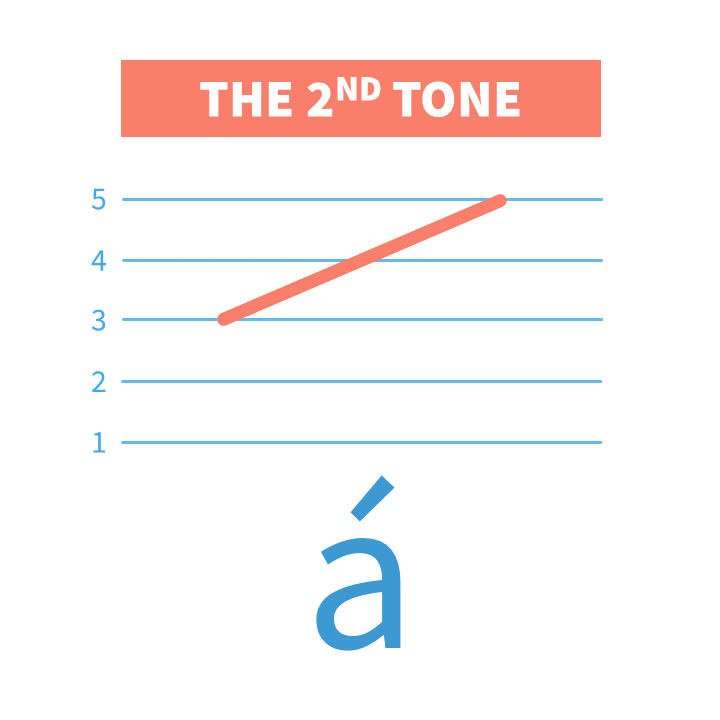Tone Lesson 3 – The Second Tone with Tone Pair Drills

CHINESE SECOND TONE
The Chinese Second Tone is also known as “The Rising Tone”. In Chinese, it is called 二声(èr shēng), literally meaning “the second sound”. In this lesson, we will be practicing the Mandarin Pinyin Second Tone with Tone Pairs and sentences.
How to Pronounce Mandarin Pinyin Second Tone
It starts semi-high and goes up. And because of this, it is also called "The Middle Rising Tone".

Practice Mandarin Pinyin Second Tone
SECOND TONE + FIRST TONE
| TONE PAIRS | ||
|---|---|---|
| PĪNYĪN | 汉字 | ENGLISH |
| zuó tiān | 昨天 | yesterday |
| fáng jiān | 房间 | room |
| shí jiān | 时间 | time |
| lí kāi | 离开 | to leave |
| xióng māo | 熊猫 | panda |
| SENTENCE | ||
| zuó tiān lí kāi fáng jiān | ||
| 昨天离开房间。 | ||
| (Someone) left the room yesterday. | ||
SECOND TONE + THIRD TONE
| TONE PAIRS | ||
|---|---|---|
| PĪNYĪN | 汉字 | ENGLISH |
| píng guǒ | 苹果 | apple |
| méi yǒu | 没有 | not; not have; without |
| niú nǎi | 牛奶 | milk |
| yóu yǒng | 游泳 | to swim |
| yá chǐ | 牙齿 | tooth |
| SENTENCE | ||
| méi yǒu ná píng guǒ hé niú nǎi | ||
| 没有拿苹果和牛奶。 | ||
| (Someone) hasn’t take the apple or the milk. | ||
SECOND TONE + FOURTH TONE
| TONE PAIRS | ||
|---|---|---|
| PĪNYĪN | 汉字 | ENGLISH |
| qián miàn | 前面 | front |
| yán sè | 颜色 | color |
| yí yàng | 一样 | the same |
| wén huà | 文化 | culture |
| xí guàn | 习惯 | customes |
| SENTENCE | ||
| wén huà hé xí guàn yí yàng | ||
| 文化和习惯一样。 | ||
| (Their) cultures and customes are the same. | ||
It helps me to think of the 2nd tone as a question, such as “What?” The 4th tone sounds angry.
I have problems reading the sentences because it’s too much at once for me. I have to think about how to pronounce each word carefully.
1st and 3rd tone are easy. Going to have to do a ton of practice to be able to differentiate between 2nd and 4th. Some is more obvious and other times it’s super hard to tell. Does it get easier with time to tell the difference?
I have the same problem, especially with the 2nd tone. I think it is easier to differentiate 4th tone because it is shorter to pronounce
Same here; they sound a lot alike to me but listening to the length of the tone helps! The 4th tone is supposed to be shorter, after all!
When I first did an exercise like this one, I was not getting them all correctly and had the same issues. I’ve been in China now 9 months, listening daily to conversations, which I don’t understand. But: I did develop an ear for it, as I’m not getting them all correctly. So yes, it gets easier with time.
These are hard to pick up. Especially in the quizzes. Some are more obvious than others.
Here I missed 2 2, though in the sentence méi yǒu ná píng guǒ hé niú nǎi it did occur by accident in the hé niú. Is there a special reason for not covering repeated same tones (other than 3 3 later)?
3rd Tone + 3rd Tone is one of the most important Tone Changes in Chinese pronunciation, if not the most important. If we speak without the Tone Change for 3rd Tone + 3rd Tone, then it’s incorrect, but with 2nd Tone + 2nd Tone, if we speak with the exact same pitch range for both syllables, it would not be considered incorrect. That is why for repetition of same Tones, we only cover the ones where Tone Change has to be involved.